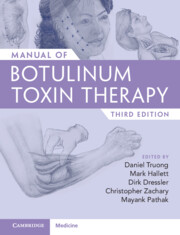42 results
Chapter 11 - Botulinum Neurotoxin Therapy of Laryngeal Muscle Hyperactivity Syndromes
-
-
- Book:
- Manual of Botulinum Toxin Therapy
- Published online:
- 02 November 2023
- Print publication:
- 23 November 2023, pp 82-88
-
- Chapter
- Export citation
Contributors
-
- Book:
- Manual of Botulinum Toxin Therapy
- Published online:
- 02 November 2023
- Print publication:
- 23 November 2023, pp ix-xiv
-
- Chapter
- Export citation
Chapter 5 - Examination and Treatment of Complex Cervical Dystonia
-
-
- Book:
- Manual of Botulinum Toxin Therapy
- Published online:
- 02 November 2023
- Print publication:
- 23 November 2023, pp 23-33
-
- Chapter
- Export citation
Chapter 10 - Botulinum Neurotoxin in Oromandibular Dystonia
-
-
- Book:
- Manual of Botulinum Toxin Therapy
- Published online:
- 02 November 2023
- Print publication:
- 23 November 2023, pp 73-81
-
- Chapter
- Export citation
Chapter 3 - Pharmacology of Botulinum Toxin Therapy
-
-
- Book:
- Manual of Botulinum Toxin Therapy
- Published online:
- 02 November 2023
- Print publication:
- 23 November 2023, pp 13-17
-
- Chapter
- Export citation
Dedication
-
- Book:
- Manual of Botulinum Toxin Therapy
- Published online:
- 02 November 2023
- Print publication:
- 23 November 2023, pp v-vi
-
- Chapter
- Export citation
Index
-
- Book:
- Manual of Botulinum Toxin Therapy
- Published online:
- 02 November 2023
- Print publication:
- 23 November 2023, pp 348-352
-
- Chapter
- Export citation
Copyright page
-
- Book:
- Manual of Botulinum Toxin Therapy
- Published online:
- 02 November 2023
- Print publication:
- 23 November 2023, pp iv-iv
-
- Chapter
- Export citation
Preface for the Third Edition
-
- Book:
- Manual of Botulinum Toxin Therapy
- Published online:
- 02 November 2023
- Print publication:
- 23 November 2023, pp xv-xvi
-
- Chapter
- Export citation
Contents
-
- Book:
- Manual of Botulinum Toxin Therapy
- Published online:
- 02 November 2023
- Print publication:
- 23 November 2023, pp vii-viii
-
- Chapter
- Export citation
Chapter 2 - Botulinum Neurotoxin
-
-
- Book:
- Manual of Botulinum Toxin Therapy
- Published online:
- 02 November 2023
- Print publication:
- 23 November 2023, pp 9-12
-
- Chapter
- Export citation
Chapter 39 - Treatment of Focal Hand Dystonia
-
-
- Book:
- Manual of Botulinum Toxin Therapy
- Published online:
- 02 November 2023
- Print publication:
- 23 November 2023, pp 332-347
-
- Chapter
- Export citation
Chapter 8 - Treatment of Cervical Dystonia
-
-
- Book:
- Manual of Botulinum Toxin Therapy
- Published online:
- 02 November 2023
- Print publication:
- 23 November 2023, pp 58-68
-
- Chapter
- Export citation

Manual of Botulinum Toxin Therapy
-
- Published online:
- 02 November 2023
- Print publication:
- 23 November 2023
13 - Posttraumatic Dystonia
- from Section I - Basics
-
-
- Book:
- Treatment of Dystonia
- Published online:
- 31 May 2018
- Print publication:
- 07 June 2018, pp 66-67
-
- Chapter
- Export citation
Case Studies in the Advancement of Parkinson's Disease
-
- Journal:
- CNS Spectrums / Volume 13 / Issue S18 / December 2008
- Published online by Cambridge University Press:
- 07 November 2014, pp. 3-6
-
- Article
- Export citation
Contributors
-
-
- Book:
- Case Studies in Pain Management
- Published online:
- 05 October 2014
- Print publication:
- 16 October 2014, pp xi-xv
-
- Chapter
- Export citation
Chapter 9 - Botulinum neurotoxin in oromandibular dystonia
-
-
- Book:
- Manual of Botulinum Toxin Therapy
- Published online:
- 05 February 2014
- Print publication:
- 23 January 2014, pp 64-70
-
- Chapter
- Export citation

Manual of Botulinum Toxin Therapy
-
- Published online:
- 05 February 2014
- Print publication:
- 23 January 2014
Chapter 11 - Botulinum neurotoxin therapy of laryngeal muscle hyperactivity syndromes
-
-
- Book:
- Manual of Botulinum Toxin Therapy
- Published online:
- 05 February 2014
- Print publication:
- 23 January 2014, pp 85-91
-
- Chapter
- Export citation



